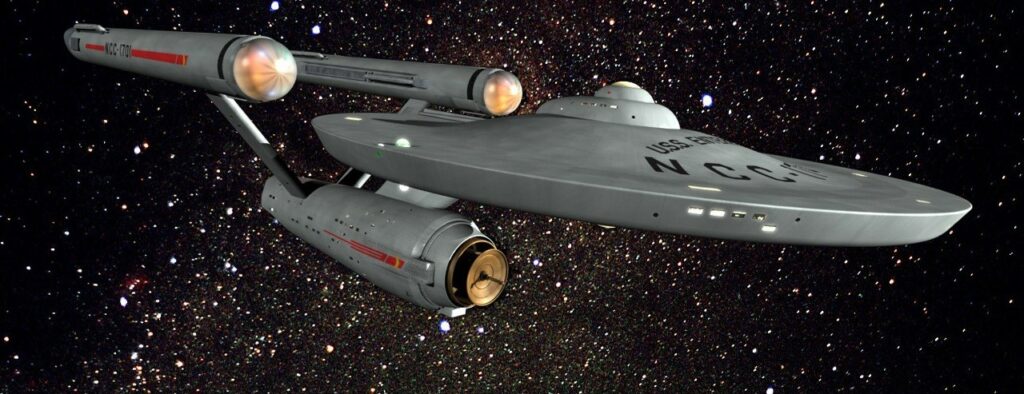
[This article (after the AAR) has been significantly modified on 29/12/2022 after some email exchanges with Don Daglow]
[This article (after the AAR) and the dating in the title have been modified on 25/06/2023 after some heavy digging in the history of this version, with the help of an anonymous commenter who pointed me many inconsistencies in the “official” story.]
Well, Lieutenant Narwhal. Yet another assignment for you. Congratulations! You will return to the USS Enterprise. You know, NCC-1701! The good news is that you will be immediately operational!
But ! Sir ! I thought we said “no more Star Trek” !
Yes ! Yes ! We said that ! But this one is neither a Star Trek (1971)-clone nor a Star Trek (1973, aka Trek73)-clone. And it is attributed to Don Daglow !
One of the reasons I don’t watch Star Trek on a regular basis is that there are too many “Kirk, Spock, McCoy and Ensign Jones beam down to investigate a mysterious signal on an uncharted planet” episodes and not enough “Eat photon torpedoes, hostile alien with a weird warrior culture !” episodes. Luckily, Don Daglow’s Star Trek cuts to the chase and puts you immediately in the kind of situation I like :
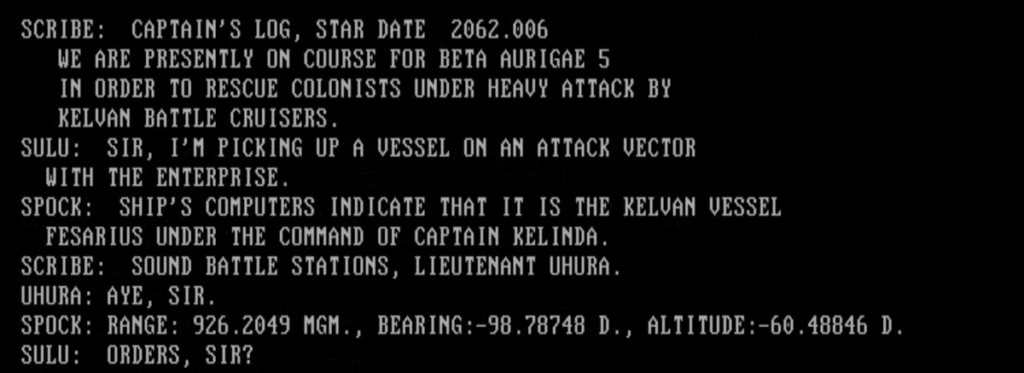
It looks like I am fighting “Kelvans” this time. Apparently, they are gigantic creatures with hundred of tentacles, but conveniently they are also shapeshifters and were only ever met by humankind while in humanoid form.
Just like in Trek73, the game is played using a list of orders :
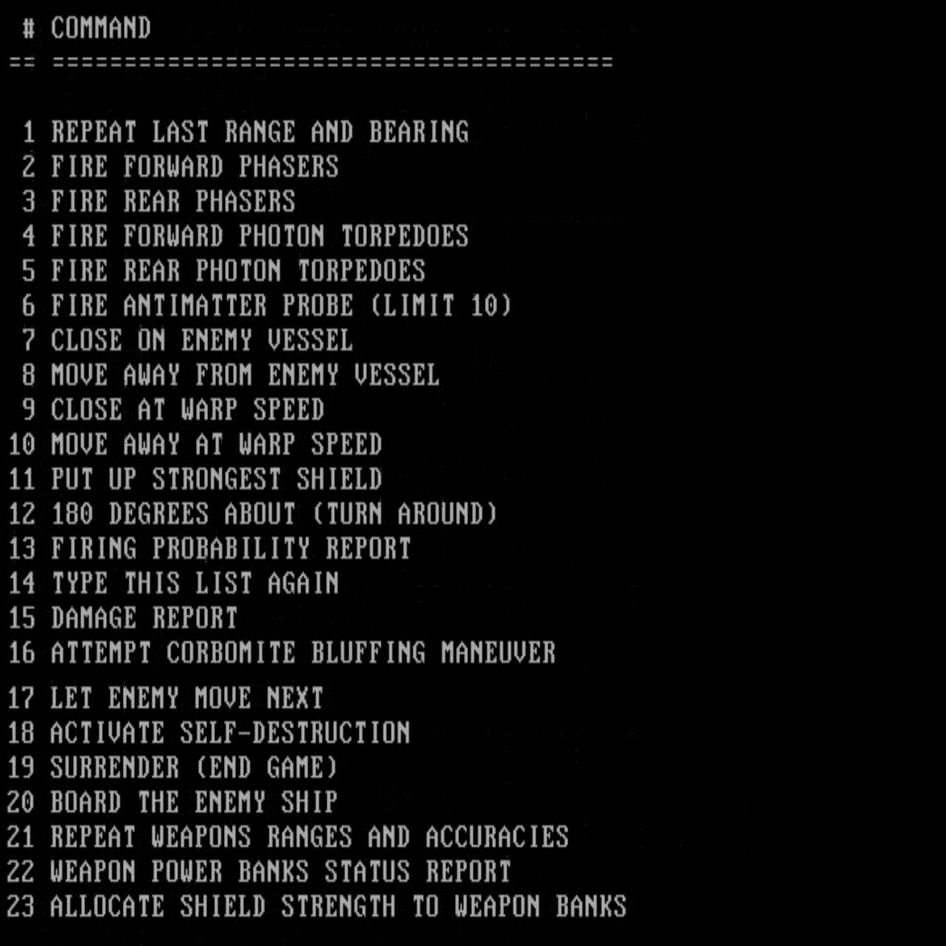
Unlike Trek73, there are very few options related to navigation : I can only move toward or away from my target. Well, let’s shoot then! I have 3 weapons available (plus the transporter if I am into boarding actions), with different ranges :
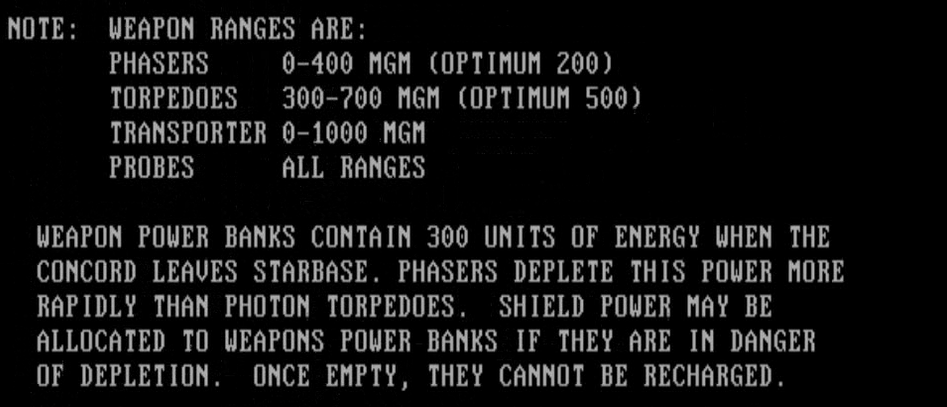
My target is at 926 MGM, so probe it is !
Missed :

Well, time for torpedoes then. I apparently have 50% chance to miss… but I try to shoot one of my frontal torpedoes when the enemy is behind me :

I got 29 casualties, but worse, much worse, I looked like an idiot in front of Mr. Spock. Making a similar mistake 5 times will result in Spock immediately relieving from command for incompetency !
After that mistake, there is a fruitless exchange of torpedoes, until one of mine hits its target :
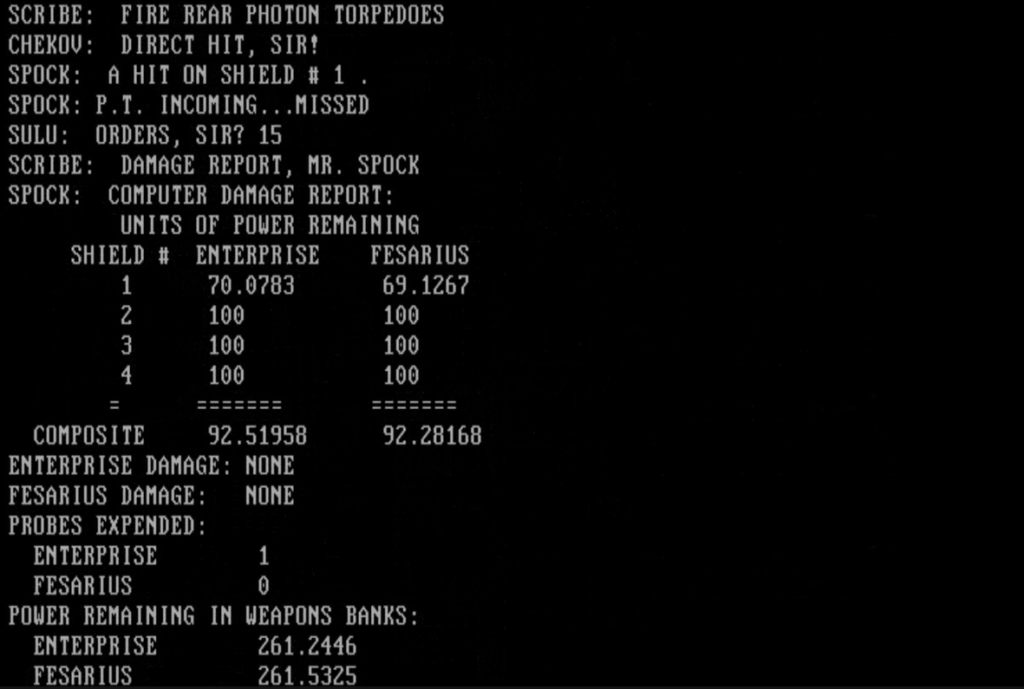
The Fesarius is now matching my speed, and we can carry on exchanging torpedoes – maybe 15 or 20 of them. I am hit sometimes, but the Fesarius is hit a lot more, and all its phasers are destroyed !
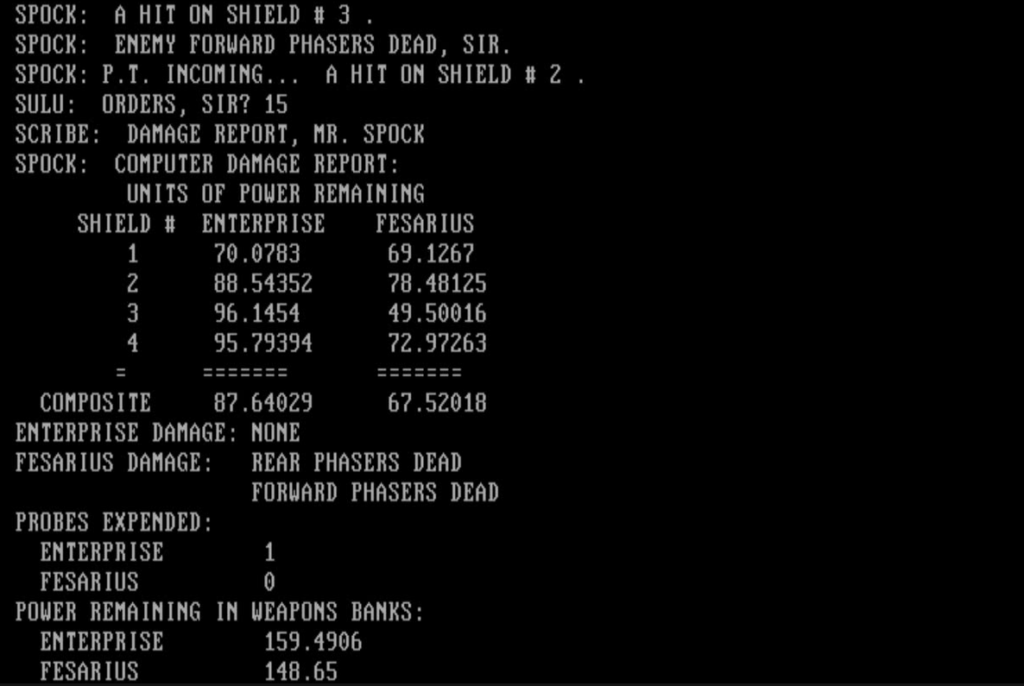
The safest course of action is now to get close at phaser range and blow up the Fesarius to smithereens.
Easier said than done. With so few options to control the ship, I sometimes end up further away from my target when ordering Mr. Spock to close in on my target !
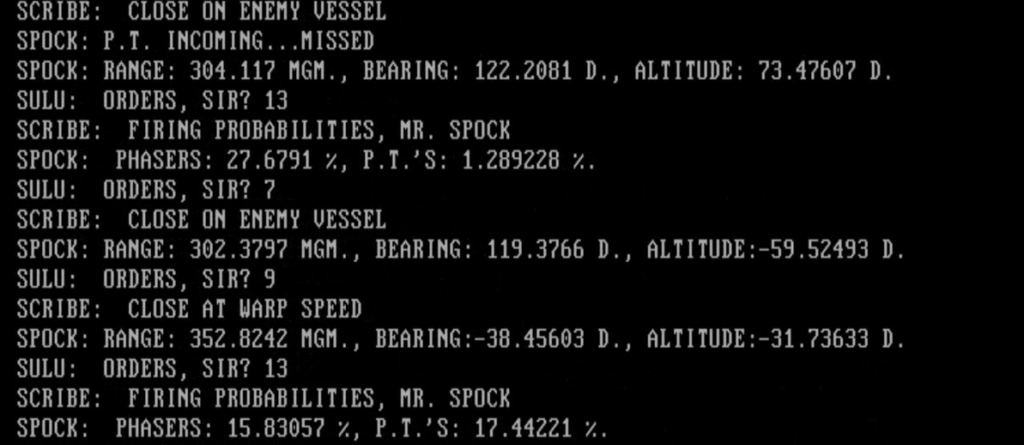
Eventually I managed to get close enough, soon destroying the enemy torpedo launchers !

Out of options, the Kelvans try to launch some inaccurate probes, but they have only 10 of them and soon run out. Just to assert dominance, I send one of my own probes, and bullseye ! Their ship is crippled and unable to escape – they have to surrender.
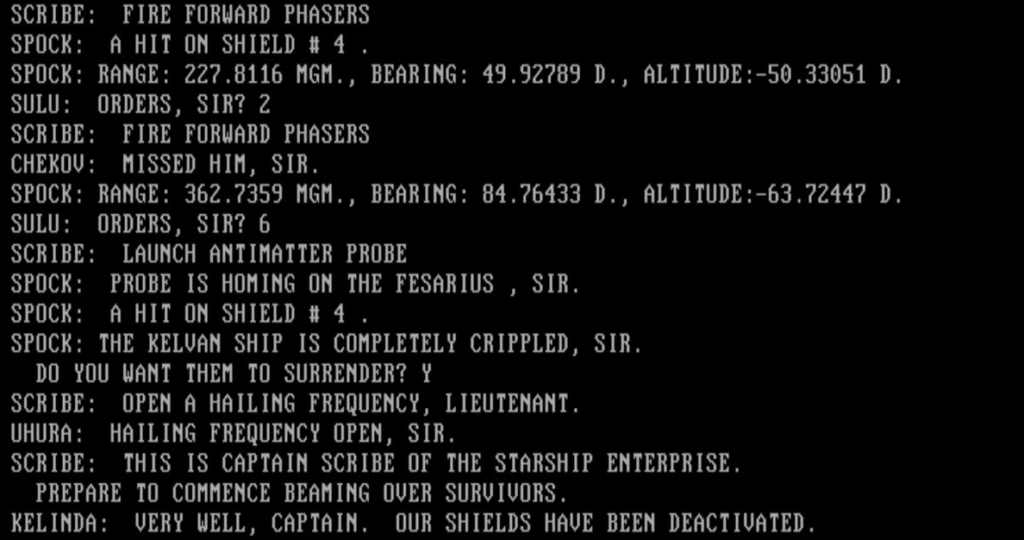
Finding the Star Trek attributed to Don Daglow was a bit of a surprise. First, I considered it lost until I realized the streamer Retro Gaming Junction had posted a video of it in July 2021, with a link to the source code. Second, I always assumed that the game was a Star Trek (1971)-clone, and the game I played has a lot more in common with the later Trek73. My incorrect assumption, which I repeated in the previous version of this article, comes from the fact that Daglow consistently described his Star Trek not as a game he designed himself but as a more narration-driven iteration of a Star Trek already circulating in his college, and of course the only famous 1971 Star Trek is Mike Mayfield’s “STTR1“. I also made the mistake because, quite frankly, most of the usually trustworthy internet sources did the same mistake – though not all.
Daglow confirmed to me by email that the Star Trek branch he worked on was started by Bill Peterson, who should be considered the original designer. Daglow asked me to make it clear that Peterson was the author and him the “modder” ; he never mentioned the name of Peterson before because… so many years later he had forgotten Peterson’s name until I sent him the previously-lost source code.

The official context surrounding this early Star Trek is well-known, as Daglow is committed to preserving the history of video games and has given a lot of interviews about his role during the heroic era, the most complete of which is the one he gave to the Smithsonian. A playwright major, Daglow attended Pomona College in Claremont, California, and by chance lived in a dormitory in which a computer terminal had been set up. He was immediately fascinated by computers and very soon learned BASIC by programming Ecala, a “tribute” to the famous ELIZA. Two weeks into this project, he realized he knew enough for more ambitious projects, first Baseball and then in November 1971 his iteration of Peterson’s Star Trek. It was immediately popular, according to one of his articles published in May 1986 in Computer Gaming World, where incidentally he claimed to have created and not only modified this Star Trek :
Games travelled across the country particularly well on PDP-10’s thanks to Digital Equipment’s DECUS public domain software sharing service. A version of Star Trek that I created ended up bringing me letters from all over the country, some of praise, some of thoughtful criticism, and even one from a guy in Berkeley who actually thought gaming was a new art form. I wish I’d saved the letter so I could proclaim him a prophet; at the time I thought he was crazy. Many of these games ended up adapted for micros and published as listings in books and magazines. Twice I’ve even found my code published in games collections under other peoples’ names!
That’s Daglow’s version anyway. Alas, it does not fit our digital footprints of this era. In particular, the “popular” Daglow’s Star Trek cannot be found in any early DECUS list for the PDP-10 (unlike Mayfield’s Star Trek, and many other games). On the other hand, we do have a 1975 scan of the listing of BASTREK, an undated but clearly early version of today Peterson’s Star Trek (he is credited in the introduction). Daglow claims to have added his features in 1972 (or, in other interviews, in 1971…), but clearly in 1975 a version without those additions was still played. It could be a different branch from Daglow, or it could be that Daglow modified BASTREK in 1974 (the year of his graduation), and then added earlier dates for bragging rights. I am inclined to go for the second explanation, due to its absence in the DECUS lists and because by coincidence Daglow’s has another game in a similar situation of being described by him as extremely popular while not being found in any archive : DUNGEON – but that one is a problem for the cRPGAddict.
Some of Peterson/Daglow’s Star Trek features are very similar to those of William’s Char Trek73‘s :
- the introduction (including a mission, a ship name, an enemy race and the name of the enemy ship and captain),
- the immersive way the crew reacts to your orders or to enemy actions
- some oddly specific orders like the corbomite bluff, which according to Daglow were already in Peterson’s 1971 code,
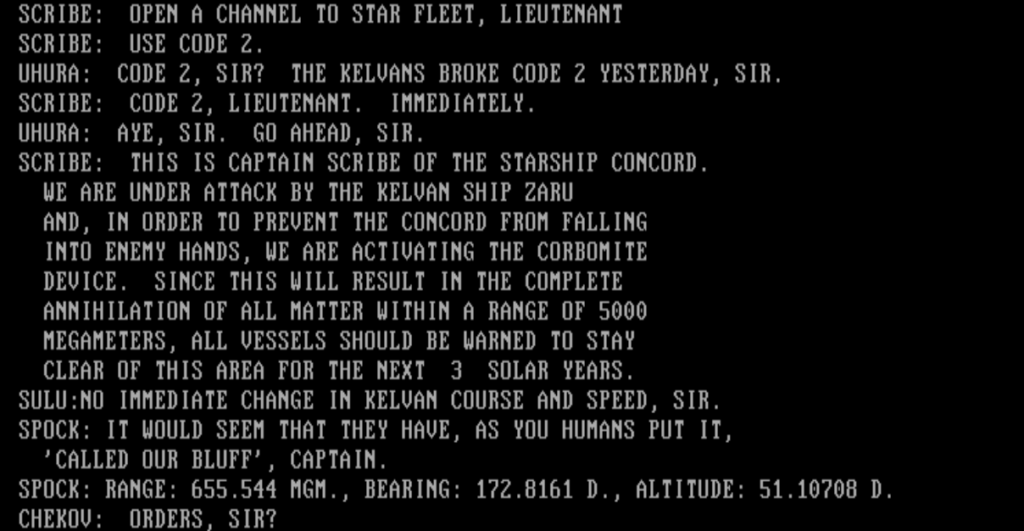
On the other hand, Trek73‘s gameplay is distinctive : the game can manage several enemies simultaneously and the player has to manage the bearing of their ship but also the orientation of its weapon. One of the Star Trek has been influenced by the other, but given the issue with dating the Peterson Star Trek it is hard to say more. I am going to tag this one 1974 in my indexes, but that’s an educated guess – for all I know Peterson’s initial effort was indeed in 1971.
Trek73 is by far the superior game as Peterson/Daglow’s Star Trek gives too much sway to luck and has fewer tactical options. Still, Daglow’s Star Trek seems to have inspired at least Deepspace (1975) that I had erroneously called a Trek73-lite.

When I started this blog, I never imagined I would spend so much time playing Star Trek games, but I believe those are now behind me for a long time. For the coming updates, we will go back to Earth with Norway 1985, the last opus of the 1985 series, in which the snow speaks Norwegian.